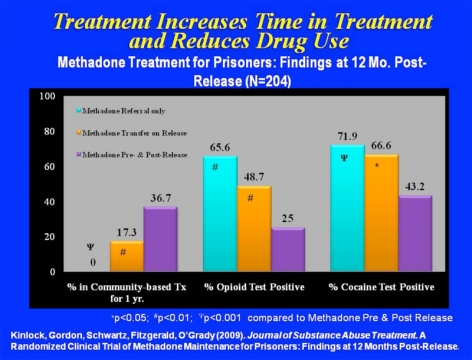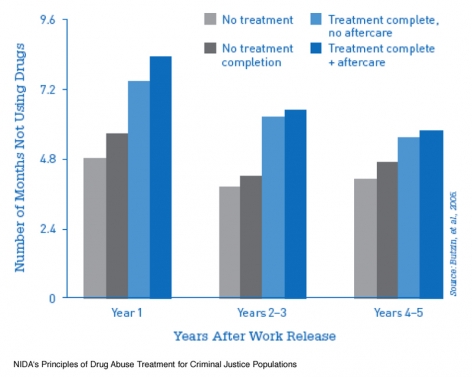Topics in Brief: Treating Offenders with Drug Problems: Integrating Public Health and Public Safety
Revised May 2011
Juvenile Offenders:
Virtually every juvenile offender should be screened for drug abuse and mental disorders, and should receive an intervention:
- Treatment for those who are dependent on alcohol or drugs, or mentally ill.
- Drug abuse prevention for those who are not.
- HIV prevention or treatment as needed.
Extent of Problem
The number of adults involved in the criminal justice system has soared from about 1.8 million in 1980 to 7.2 million in 2009. The connection between drug abuse and crime is well known - one-half to two-thirds of inmates in jails and State and Federal prisons meet standard diagnostic criteria (DSM-IV) for alcohol/drug dependence or abuse. Yet only 7% to 17% of these prisoners receive treatment in jail or prison, so that most of the over 650,000 inmates released back into the community each year have not received needed treatment services.
Left untreated, drug-abusing offenders can relapse to drug use and return to criminal behavior. This jeopardizes public health and public safety, leads to re-arrest and re-incarceration, and further taxes an already over-burdened criminal justice system.
Treatment Can Work with Criminal Justice Populations
Multiple studies have examined treatment approaches that integrate drug abuse treatment into criminal justice settings. These approaches include therapeutic communities (TCs) in prison and community work-release settings, drug courts designed to blend treatment with judicial monitoring and sanctions, Treatment Accountability for Safer Communities (TASC) case management approaches, and drug treatment alternatives to incarceration.
Research shows that combining treatment medications, where available, with behavioral therapy is the best way to ensure success for most patients. Yet despite known efficacy, pharmacological treatments for drug addiction are underused in the criminal justice system. The clinical trial results in Figure 1 show that enrolling prisoners addicted to opioids in methadone treatment prior to release and linking them to continuing community-based treatment at re-entry is effective for increasing treatment retention and reducing drug use.
Aftercare is a Necessary Component of Treatment
In addition to treatment in prison, research strongly indicates that continuing treatment in the community is needed to sustain these gains. Combining prison-based treatment with community-based treatment upon release reduces an offender's risk of recidivism, decreases substance abuse, improves prospects for employment, and increases pro-social behavior (see Figure 2). Case management and referral to other medical, psychological, and social services are crucial components of treatment for many offenders.
Treatment for adults and adolescents is cost-effective because it reduces costs related to drug use, health care, and crime, including incarceration costs. Adding an aftercare component to in- and out-of-prison treatment programs reaps the greatest cost savings.
NIDA's Integrated Public Health – Public Safety Response
Research demonstrates that providing treatment to individuals involved in the criminal justice system decreases future drug use and criminal behavior while improving social functioning. Blending the functions of criminal justice supervision with drug abuse treatment and support optimally serves both public health and public safety concerns.
NIDA's research portfolio examining the integration of drug treatment into criminal justice settings includes the Criminal Justice Drug Abuse Treatment Studies (CJDATS) — a multi-site, research collaborative launched with several partners that tests evidence-based approaches for treating drug abusing offenders to improve their outcomes.
The aims of the NIDA criminal justice portfolio are (1) to develop treatment programs that are available to offenders moving throughout the criminal justice system; (2) to enhance HIV and other infectious disease treatment and prevention with offenders; and (3) to facilitate the transportation of effective and evidence-based treatment practices and services into the criminal justice system.
Addressing Public Health Problems Associated with Drug Abuse
Substance abusing individuals in the criminal justice system have a host of complicated health problems. Involvement in the criminal justice system provides an opportunity to diagnose and treat these health problems, which include infectious diseases. The prevalence of AIDS is estimated to be approximately five times higher among incarcerated individuals than in the general population. In addition, individuals in the criminal justice system represent a significant proportion of all cases of hepatitis B and C infection and tuberculosis in the United States. Increasing participation in drug abuse treatment can decrease the spread of these diseases by reducing risky behaviors, such as sharing injection equipment and having unprotected sex.
It is a public health — and safety — issue that cannot go unheeded.




